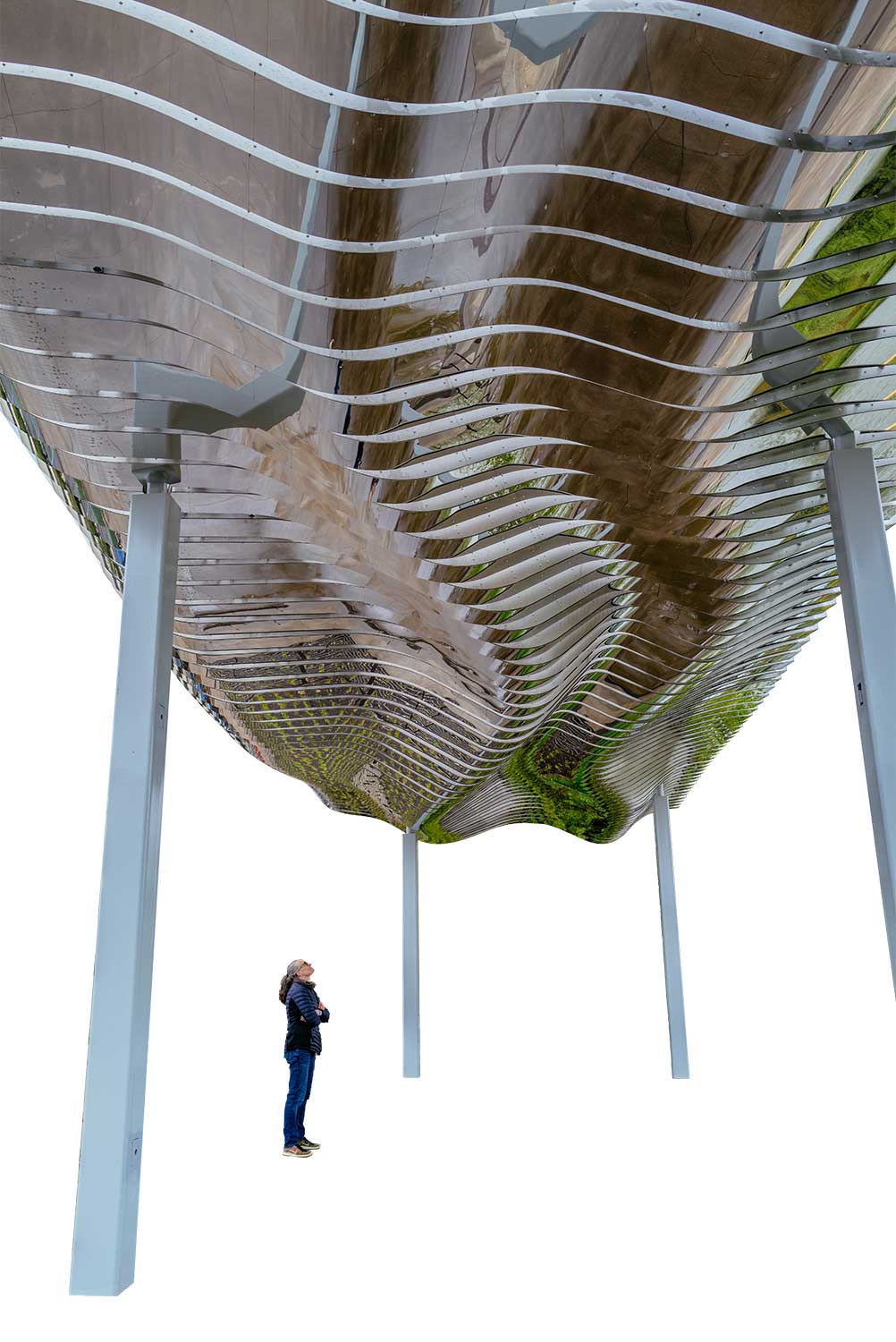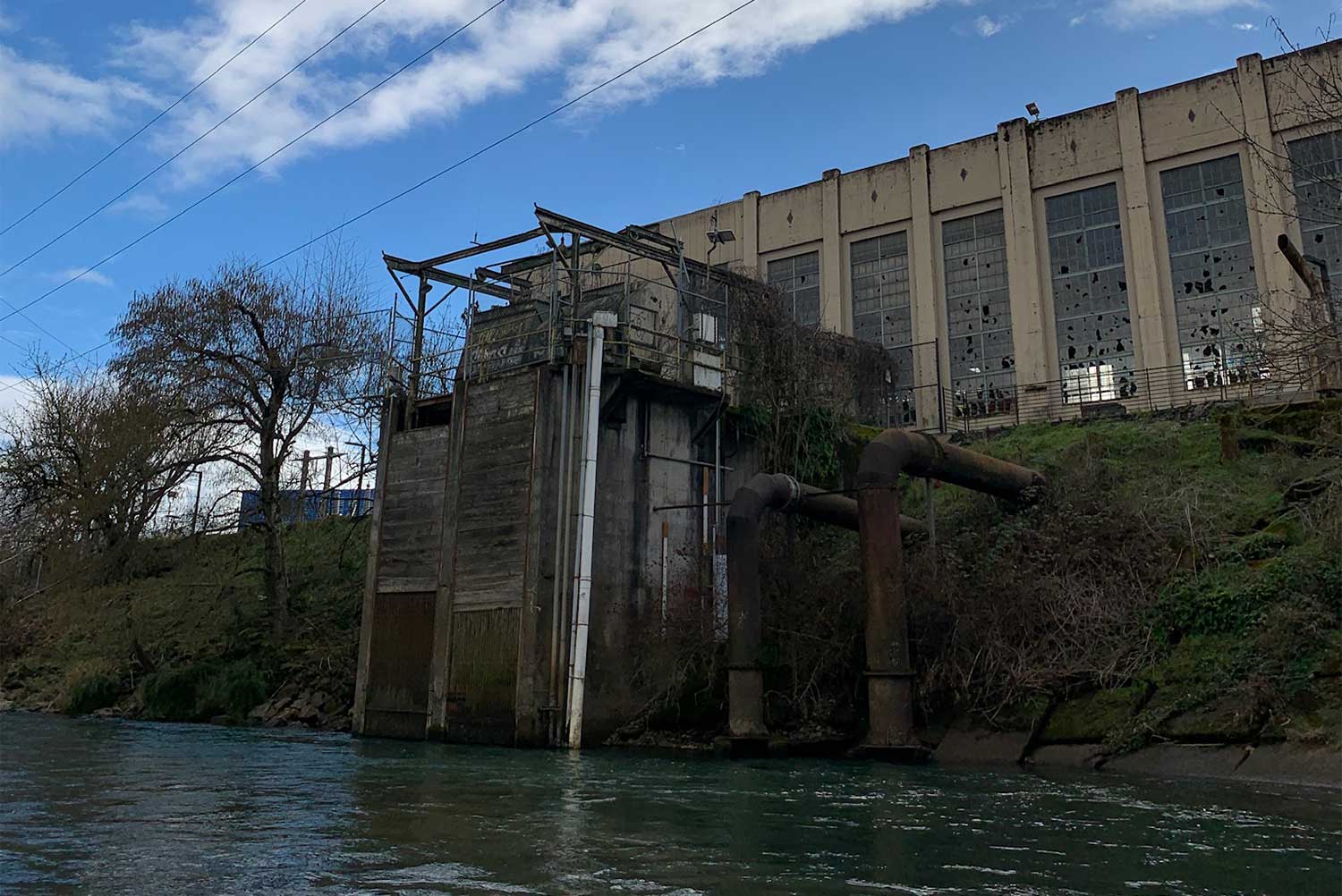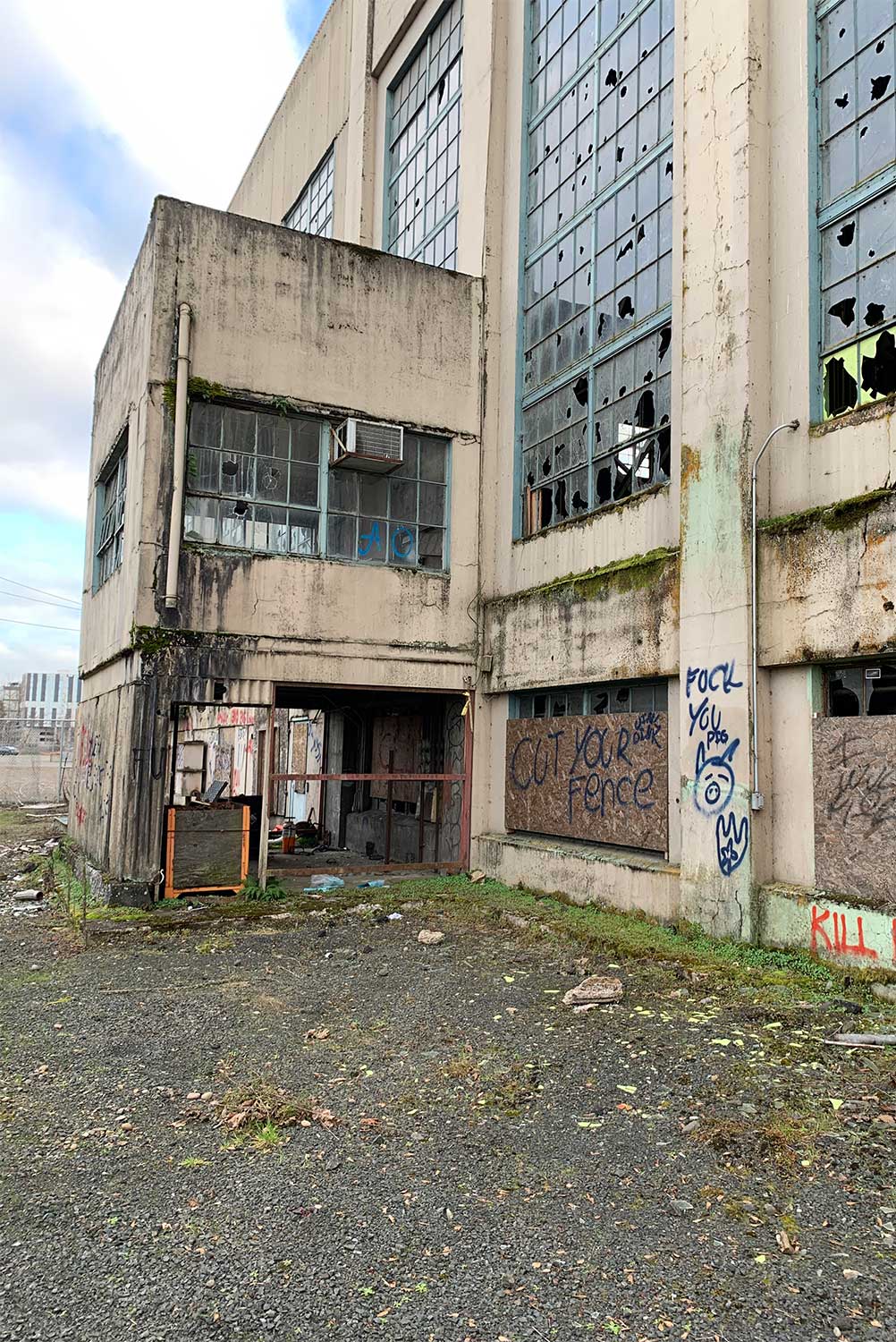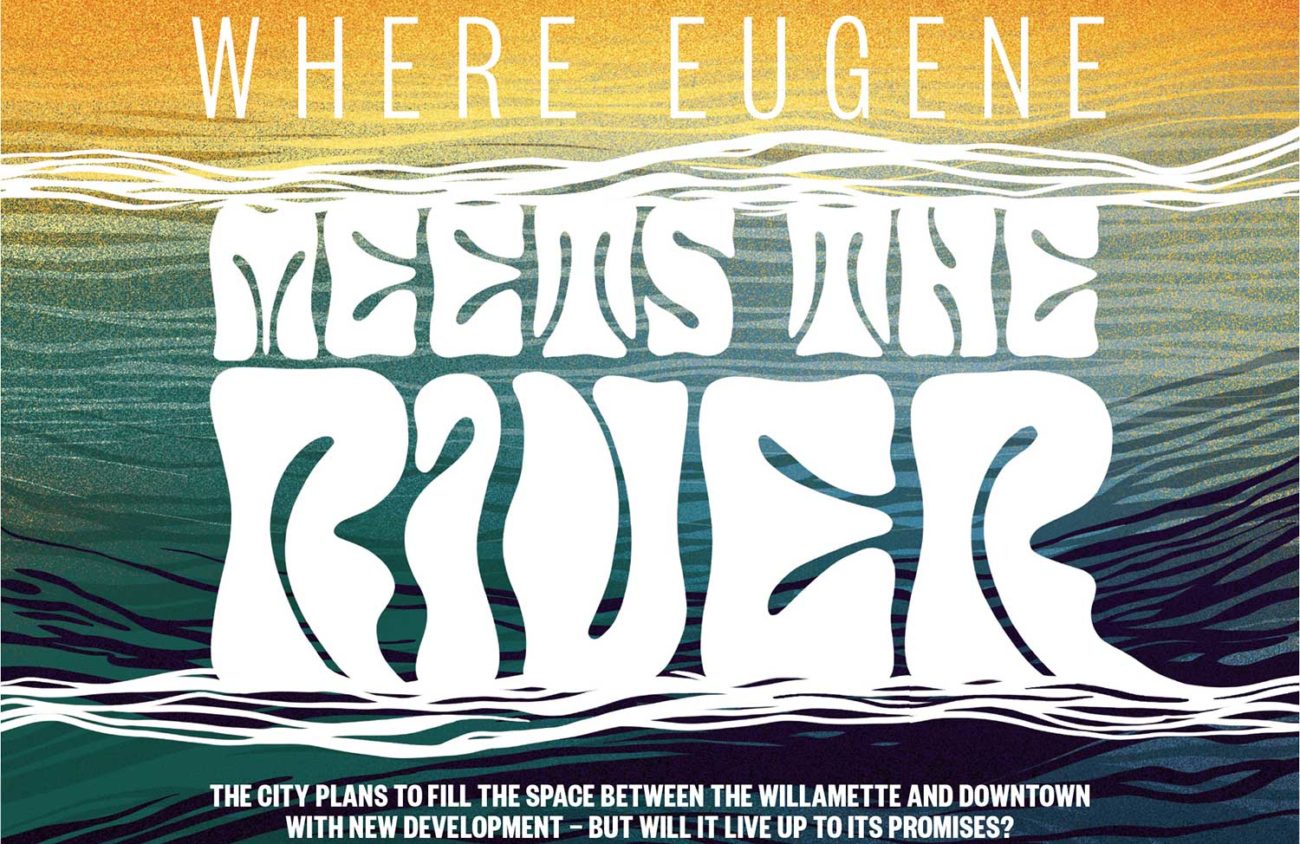Wrapped in a bright yellow life vest, Michelle Emmons sits atop the inflatable blue dinghy’s stern, her dark brown hair pulled taut into a high bun. She’s in the middle of the Willamette River, just paces away from downtown Springfield. It’s unseasonably sunny and warm for the first day of February.
The water shimmers in the late-afternoon light, reflecting hues of worn denim and sea-foam green. Low, white waves crest and ripple over the rocky riverbed, sending cold spray into the boat as she paddles downstream.
Emmons is the Upper Watershed Program manager for conservation group Willamette Riverkeeper. She’s here to bear witness to the intimate relationship between the Willamette and the people who call its banks home, and how that relationship is changing.
In Eugene, that change is coming in the form of a 15-year urban development project that will see the downtown portion of the riverfront transformed into a glossy high-end neighborhood, complete with market-rate apartment buildings, a three-acre urban park and a one-acre urban plaza. There’ll be art installations, restaurants, public performance space, a near-total transformation of the historic Eugene Water and Electric Board Steam Plant, and 75-units of moderate-income housing.
Altogether, developments on the downtown riverfront will cost hundreds of millions of dollars of mostly private investment, aided by a few smaller chunks of the city’s urban renewal budget. The development is happening on a 27.8-acre property situated between the old EWEB Steam Plant and the DeFazio Bicycle and Pedestrian Bridge, in an area most recently used by EWEB to store industrial equipment.
City planners see the riverfront development as an opportunity to connect downtown Eugene with the Willamette, closing the awkward gap that’s formed between the urban core and the river since EWEB began relocating its operations in the mid 2000s.
If all goes according to the city’s plan, the expansive private investment on the riverfront will turn the once-desolate area into a pleasant place to be, encouraging all Eugeneans to enjoy the spectacle of America’s 13th largest river by volume.
“If you want people to do something, make it easy,” says Eugene City Councilor Emily Semple. “Some people might not even remember that we have a river here.”
Enlarge

River Roots
From its tributaries in the mountains southeast of Eugene, the mainstem of the Willamette flows 187 miles north until merging with the Columbia River near Portland. It contributes 12 percent of the Columbia’s total flow. Two-thirds of Oregon’s population lives in its river valley.
The Willamette is voluminous, but also wide — over a quarter mile near its mouth. As Emmons paddles downstream, she passes gentle stretches of muddy beach dotted with wading blue herons, some camouflaged against the shadows of the overhanging willows and dogwood. Osprey nests top the tallest trees like thorny crowns. In some sections, greenery along the bank obscures the human world, conjuring a sense that this place has changed little since the Kalapuya traversed its waters in canoes. In others, the bank is defined by man-made riprap — stacked boulders held together by metal wire used to prevent erosion — and flanked by railyards, industrial parks and half-finished residential projects.
On a sunny patch of floodplain, a retiree in khaki waders plays Frisbee with his dog. A few yards downstream, a college-aged woman reads on a sun-soaked rock, nestled amongst the drooping willows. Farther down, the rocky beach near the Autzen footbridge waits patiently for the first warm days of spring, when rowdy University of Oregon students will emerge bleary-eyed from winter hibernation for a drunken dip.
Eugene is where it is today because of the river. For the bulk of the city’s history, water from the Willamette was used for industrial power and the production of steam used to heat downtown. For most of the 20th century, EWEB owned the downtown portion of the riverfront, using the space’s prime location next to the EWEB headquarters at the north end of the site to store industrial equipment like power poles, transformers and utility vehicles.
The site’s long history of industrial use, and of flooding in the era before dams were built, means that pollution and heavy industry have prevented any development on the site until recently, and it has been hazardous and expensive for the city to maintain. After EWEB relocated to west Eugene in 2010, the city bought 16 acres of the site in 2018 for $5.75 million. It bought another three acres for $1 from EWEB — a symbolic gesture, agreed upon under the condition that the city would build a public park there. Most of the remainder of the 27.8-acre site belongs to the one-acre urban plaza and the EWEB headquarters building, which EWEB put up for sale in February. The utility is accepting proposals for its purchase in the spring and summer of 2022.
According to Eugene Community Development Co-director Will Dowdy, the city’s shift away from industrial operations along the river is part of a larger global trend. Waterfront areas once essential for heat, power and electricity have gone vacant as cities become less reliant on heavy industry, creating awkward gaps between the water and the urban core. A similar process happened in Portland in the 2000s with the South Waterfront District, and is happening currently with the city of Springfield’s Glenwood Riverfront Refinement Plan.
“Sites that have great natural features because of their proximity to the water are no longer needed for utilitarian uses,” Dowdy says. “Suddenly, they’ve become opportunities for communities to improve quality of life by getting people closer to nature and creating amenities for those communities.”
Thinking of a Master Plan
When EWEB began its relocation in 2007, the utility commissioned local architecture firm Rowell Brokaw Architects to write a master plan for the site detailing a long-term vision for the property. An elaborate public engagement process followed, involving more than 1,000 participants whose input informed the designs in the plan. The architects say public engagement for the EWEB Riverfront Master Plan was unmatched in scale and depth.
“What made the riverfront special was that everyone in the city, in EWEB and in the community kind of knew that this was one of the most important things in Eugene in a generation,” says John Rowell of Rowell Brokaw.
Public engagement for the Downtown Riverfront’s design began when EWEB and the city selected a nine-member community advisory team from a pool of applicants. The group met in July 2008 at the EWEB headquarters, in a meeting open to all community members. Rowell says more than 100 people attended. The team presented details about the site and its history, providing an educational background before the design process began.
The architects hosted a design workshop in October 2009 to inform the design presented in the master plan. UO faculty, landscape architects and downtown business owners worked for six hours on a Saturday afternoon, using paper cutouts and large aerial photographs of the riverfront site until eight design ideas emerged.
The architects incorporated the ideas into a single design scheme, which the EWEB board then voted to approve. Rowell and his colleagues — along with local landscape architecture firm Cameron McCarthy — worked to synthesize the design outlined in the master plan into an amendment to the Eugene land-use code. In the following years, the city held numerous public outreach events, including surveys, focus groups, and tours of the park and Steam Plant.
But all that was years ago. The only ongoing reminders many Eugeneans have today of the changes happening on the Downtown Riverfront are the noise and excavators, and the fencing that has cordoned off a portion of the city’s central business district.
“The closures to the bike path, the preparation and digging that happened in order to lay back the riverbank — I don’t think any of that was communicated very clearly to the public,” Emmons says. “They could’ve done a better job with public outreach once the project got rolling and we started seeing changes.”
Enlarge

The Downtown Riverfront Park
Next time you’re in the Market District, walk up High Street, stop just past the railroad crossing at the 5th Avenue intersection and look to your right. Off in the distance, between the columns of the Ferry Street Bridge, beyond the empty dirt lot littered with excavators and discarded machine parts, you’ll notice a bizarre, reflective structure seemingly hovering over the river like a giant metallic cuttlefish.
This undulating canopy of shiny metal plates just south of the old EWEB headquarters is called SubSupra. The multi-purpose art installation was designed by Zoe Lewis of Jill Anholt Studio and built to emulate the curvature of the Willamette’s riverbed. It’s one of a collection of new art pieces going up along the riverbank, and the artistic centerpiece of the city’s $14.5 million Downtown Riverfront Park.
The three-acre linear park, which began construction in May 2020, is funded by a combination of state public works funds and city urban renewal money. Construction is happening in two phases. According to city landscape architect Emily Proudfoot, the city plans to open the main portion along the riverbank to the public sometime before June 15. A one-acre urban plaza — funded by urban renewal funds and $5 million of state lottery money — will finish sometime in 2024, she says.
The park was originally scheduled to open in April, Proudfoot says, but developers are still waiting on a handful of bronze sculptures, delayed by COVID-related supply-chain issues. The park will be the site of the 10-day Riverfront Festival, associated with the World Athletics Championships, starting July 15.
Designed by Portland-based landscape architects Walker Macy, the park features a wide concrete bike bath running parallel to the river, crisscrossed by narrow pedestrian paths throughout. The main path passes balconies overlooking the Willamette, one of which includes an acoustically designed wooden shade structure, curved to reflect the sounds of the gurgling river onto its seated occupants. The side closest to the Steam Plant will feature a public deck overlooking the river built out of the plant’s old intake. Proudfoot says this deck, like the rest of the park, will be publicly accessible, despite parts of the Steam Plant being reserved for the customers of private businesses.
Before the city began developing the riverfront property, the bank dropped off steeply to the water. Excessive channelization — the process by which fast-flowing water erodes a riverbank over time — was historically prevented using loose boulders locked together with riprap. This hampered the growth of native vegetation, which filters out pollution from the downtown streets before it reaches the river during rainstorms. As part of the city’s vision for connecting downtown with the riverfront, the park’s architects flattened the riverbank to help restore its natural, gentle slope, and planted native trees and bushes like dogwood, snowberry and alder.
“When you remove all the vegetation and do nothing to restore the habitat around the area, then it’s like you’re just sending that stormwater straight into the river,” says Emmons, who is also a Democratic candidate for the Oregon State Legislature, hoping to represent District 12 in the Oregon House of Representatives in 2023.
Beginning directly below the Ferry Street Bridge, numerous lush “rain gardens” filled with grasses, flowers and shrubs form breaks in the newly poured concrete, helping filter out garbage and toxins before they reach the river.
“The whole big concept of this is where the city meets the river,” Proudfoot says, “so there’s stormwater treatment built into every single one of these streets.”
While Emmons says she’s impressed with the architects’ stormwater system, she still has concerns about how future construction of the neighborhood will strain it.
“When there’s an asphalt surface right next to the river, all of a sudden, all of the chemicals from the asphalt and oils from cars have a lot less distance to travel to get to the water,” she says.
The park is under construction concurrently with the streets, sidewalks, curbs and drainage that will form the backbone of the riverfront neighborhood. Towards the end of 2022, construction of the neighborhood’s market-rate apartment buildings will begin, scheduled to finish sometime in 2025, according to the city’s website.
Enlarge

Urban Renewal?
In a historical sense, urban renewal describes the mid-20th century process through which the U.S. federal government funded urban development projects to rebuild poverty-ridden sections of cities with failing infrastructure. In many cities, including Eugene, the program did more harm than good. City governments dazzled the feds with ambitious urban designs to secure funding, then used the money to clear out slums and destroy historic city centers, causing widespread displacement and oppressive, often racist gentrification. The projects rarely lived up to their promises, inspiring a general distrust of sweeping urban developments nationwide.
Enlarge

The EWEB property sits squarely within Eugene’s Riverfront Urban Renewal District, and uses Tax-Increment Financing (TIF) for its public funding. First used by Oregon cities in the 1960s, TIF differs from the federal urban renewal program in that funding for development comes from special districts with frozen property tax rates. As the property increases in value over time, all additional tax revenue goes directly towards funding new developments in the district.
The Riverfront Urban Renewal District — created by the city in 1985 — and the nearby Downtown Urban Renewal District are Eugene’s two urban renewal districts. In the context of 21st-century Eugene, TIF is synonymous with urban renewal. Urban renewal districts are created by the City Council, which also allocates TIF funds and sits as the Urban Renewal Agency Board.
According to Mayor Lucy Vinis, a project’s budget is decided by the amount of urban renewal money the city can allocate, which then informs negotiations with developers on project details. The city’s commitment is rigid, she says, so any excess cost beyond the proposed budget is the developer’s responsibility.
Enlarge

While the city has channeled millions of public investment into the Downtown Riverfront, most of the funding comes from private developers. In contrast, the city’s widely criticized demolition of Eugene City Hall was funded by the city itself, Vinis says.
Even though the Downtown Riverfront is mostly private development, the inclusion of projects that benefit the public like the Downtown Riverfront Park and the moderate-income housing makes it an exemplary use of private investment for public benefit, Vinis says.
“As urban renewal, it’s doing what it’s designed to do,” she says. “It’s not supposed to be a public project. The purpose of urban renewal is to fund projects that provide public benefit.”
‘Mariposa’
Just past the Knickerbocker bike bridge, a white foreign mass juts out of the knee-high water — its cubic corner too geometrically precise to be sculpted by nature.
It’s a refrigerator. The riverbank along this stretch of private property — owned by Union Pacific railroad — is littered with items typically found in medicine cabinets or linen closets: blankets, clothes, towels, shoes, pill bottles, hypodermic needles, syringes, plastic cups. A few yards into the thick underbrush, a man with a brown beard and a gray baseball cap smiles and waves. He’s standing next to a blue tent, shaking the dirt off a pair of damp jeans. A smoldering fire coughs up smoke nearby.
Emmons knows this spot well. It’s one of the major sources of trash that she and her colleagues encounter during their monthly river cleanups, during which they’ve collected 1,000 pounds of trash at a time. In 2021, Willamette Riverkeeper picked up more than 40,000 pounds of trash from the river in Lane County.
Because it’s private property and not regularly patrolled by the Eugene Police Department, this area is the site of a notorious tent community known to its residents as “Mariposa” or “Mario Land,” Emmons says. People migrate here when they become displaced from other areas — often by large public works projects — drawn to its relative safety from sweeps compared to other parts of Eugene.
While most of the people she’s encountered here are peaceful, Emmons says she’s also witnessed some dangerous situations. During a river cleanup a few years back, Emmons met a teenage girl caught in a prostitution ring who told her she was pregnant and worried she might get stabbed by another camper. Another time, Emmons found a blown-out TV and a ruptured propane tank in the center of a fire pit.
The trash from this camp builds up quickly and has serious ecological effects, Emmons says. Riverbanks are popular for tent camping, but space is limited, so development of vacant riverfront land can push unhoused individuals into denser communities along the undeveloped riverbank with higher potentials for trash buildup, like Mariposa. She says there’s a noticeable connection between large public works projects, like the Downtown Riverfront development, and the displacement of unhoused individuals into areas on the riverbank.
Before the Downtown Riverfront Park began construction in 2020, Emmons says, Willamette Riverkeeper had sporadically encountered small tent communities along the eastern end of the city’s riverfront property, between the steam plant and the edge of the park.
“When we put in new developments in the places that felt more protected to the houseless community — they’re now having to migrate from those areas,” Emmons says. “Any new land use on the riverfront disperses the general houseless traffic.”
A New Neighborhood
The riverfront neighborhood won’t fully take shape for another few years. As of now, plans include three market-rate apartment buildings and one subsidized moderate-income housing development, as well as additional apartments yet to be detailed. Two of the market-rate apartments will be built adjacent to the riverfront park on the east side of the Ferry Street Bridge, while a third will be built in the large empty lot to the west. The moderate-income housing will go in a lot to the northwest of the bridge, at the corner of 4th and Mill. City planners say the moderate-income housing will include 75 units, and will be affordable to 60 percent area median income — people who make down to 60 percent of downtown Eugene’s average income.
Construction on the market-rate apartments, contracted to development company Atkins Dame Inc. in October 2021 for $4.5 million, will begin sometime in late 2022 and likely last through 2025. According to a project overview presented to the City Council by the Eugene Community Development team in a February meeting, the building to the west of the bridge will be four-stories, include 130 units and cost developers an estimated $58.6 million. The building between the bridge and Ferry Street will be four stories, 95 units and cost an estimated $42.9 million, while the building to the east of Ferry Street will be four stories,156 units and cost an estimated $58.8 million.
Each of the three buildings will have aesthetically similar facades, featuring store-front style windows and street-facing awnings meant to be appealing to passersby.
Several factors contribute to the apartments’ high development costs, says Eugene Economic Strategies Manager Anne Fifield. Development tends to be more expensive downtown, where space is more limited and developers have to worry more about security. Fifield says there’s high demand for downtown market-rate housing — housing that does not have income limits and is not funded by subsidies — but regardless, developers will have to build well-designed units with thick windows to muffle noise from the nearby train tracks if they hope to fill the buildings.
“Rents are high right now because there’s more demand than supply,” Fifield says. “And you can’t build shoddy units — nobody’s going to want to live there if the walls are too thin.”
The site also has a decades long history of industrial use. Fifield says that property inspectors found old fuel tanks buried deep below the locations of the proposed buildings — another expensive obstacle to development.
“It’s a curiously risky site,” Fifield says. “It’s been in industrial use since the late 19th century. Whatever was there left all kinds of yuck behind.”
Developers received a Multi-Unit Property Tax Exemption from the city for the three proposed buildings to help ease the burden of these added costs and encourage development. Abbreviated as MUPTE, it’s a form of tax exemption that lets developers forgo paying full property taxes during a project’s initial development phase when costs are high and revenue is low. Eugene economic analysts and developers say the apartments would not be financially feasible without receiving a MUPTE.
The market-rate apartments are all privately funded, meaning that Atkins Dame Inc. takes full responsibility for paying development costs, and incurs all financial risks associated with the project.
“If they can’t fill the building and they lose money,” Fifield says, “that’s tough luck for them. There’s no risk to the city.”
As part of the MUPTE agreement, developers must pay a percentage of their revenue to the city’s moderate-income housing fund — a pot of money that the city uses to fund subsidized housing developments around Eugene. According to Fifield, it’s unlikely that this money will be used to directly fund the riverfront’s moderate-income housing.
The 75-unit moderate-income housing will be one of the last portions of the Downtown Riverfront development to take shape, she says. It will be funded by a combination of sources that will likely include both federal and state low-income housing tax credits.
According to UO architecture professor and urban design expert Nico Larco, it’s not uncommon for subsidized housing projects to be developed later in larger urban development initiatives.
“You typically can’t start off with the affordable housing part,” he says, “because there’s no money to support it. You need other projects to come through first, so you can have the money to pay for those things.”
“We have more of a demand for affordable housing than market-rate,” says City Councilor Semple. “But you can’t build it without subsidies. We work really hard to get home funds and grants to support affordable housing, but we just don’t have enough.”
“If I had the money to buy more,” Semple adds, “we’d be building it right now.”
An Ambitious Project
When the park opens in the coming months, the mighty Willamette and the heart of one of Oregon’s largest cities will have one less degree of separation. City planners and developers are confident that the public will see the Downtown Riverfront as they do: the missing piece separating modern Eugene from its historical and geographic roots.
“The river is an important part of our identity,” Will Dowdy says. “Creating more opportunities for more people to experience the river can get us more in touch with who we are and the land we live on.”
Not all of the Downtown Riverfront will be accessible to everyone. While the riverfront neighborhood won’t include sprawling estates with manicured lawns, most of the people who live there will likely be of a certain socio-economic status.
“It will be gentrified,” Semple says. “But anyone in the city could interact with the area, not just the people who live there.”
But if the plans are to be trusted, the public will get some perks they don’t have to pay to use. A park, an urban plaza, bike paths, artwork, sweeping river views — all from a corner of Eugene that’s spent the better part of the 21st century as an industrial pole yard.
“It’s an ambitious project,” Mayor Vinis says. “But the vision is there, the planning is strong. We’ll know we’ve succeeded when the people finally get to see that vision.”
Stay tuned for coverage of the EWEB Steam Plant in part 2 of this series on Eugene’s Downtown Riverfront.
